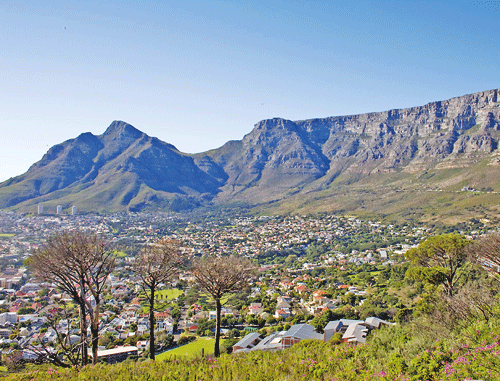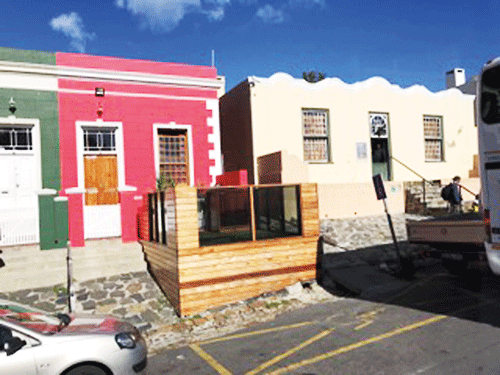Captivating Cape Peninsula and more

In the shadow of the mountain: Cape Town and Table Mountain in the backdrop
The group flew to Livingston, Zimbabwe to see the famous Victoria Falls (known as the “smoke that thunders” resting on the southern bank of the Zambezi River. The falls more than a kilometre long with a height of 100 metres are the largest in the world. Dr. David Livingstone, a Christian missionary discovered the falls in 1857 and named it after the Queen of England.
The visitor walks along the walkway sometimes splashed by the spray and from different viewpoints observes the Devil’s Cataract, the main waterfall with a veil of water gushing downwards, and the Horseshoe Falls. There are helicopter rides with panoramic views of the waterfalls, which continue into Zambia. As we circled over the falls, I glimpsed a rainbow. Zimbabwe is a very poor country with a population of 13 million now forced to use US dollars. The country relies on tourism with its agriculture and tobacco industries devastated by the land grabs. We met a young white settler working at our hotel, who had returned to the country, which she had left, calling it home.
Time was spent in a village where the villagers explained their customs, assisting each other and how marriages had to be from a different clan. Dowries were bartered in the form of labour or cows. It was taboo to marry someone from your own village. Cooking duties were shared and meals were in either the summer or winter kitchen with the males eating separately from the females. In winter, the villagers had only one meal and subsisted on berries.
Two days were spent in Botswana cruising down the Chobe River, admiring the magnificent sunsets and early morning drives in the national park. The concentration of elephants in Botswana is large and the attraction is the Okavango Delta. To go upstream by boat and see the animals feeding on the trees and moving across the water for the grass is a memorable experience. We watched two elephants crossing the water with one hanging on to the other. On another occasion an irate hippo chased our boat. Botswana has severe penalties for poachers with orders of “shoot to kill”. An evening was spent at a Boma where all game meats were available with a display of drumming and dancing.
The backdrop of Table Mountain shields the multi-cultural city of Cape Town, capital of the Western Cape with Table Bay in front. Travelling up the mountain in a revolving cable car there were picturesque 360-degree views. The summit has views of the coast and the Dassie, a rock hyrax (a hoof mammal) related to the elephant, resides on the mountain. We noticed that there were no high rises and that contractors kept to the regulations. CT was voted the World Design Capital in 2014. In fact, the NY Times and the British Daily Telegraph in 2014 also voted it the best place to visit in the world. Our hotel was near the waterfront and there are many choice restaurants on the Victoria & Albert Wharf.
The Cape Peninsula is breathtakingly beautiful with its rugged mountains, bays and views of the ocean. Our destination was the Cape of Good Hope and Cape Point Nature Reserve where we saw an Eland, ostriches and the colourful flora and fauna of the area.
On the return journey, we stopped at the historical Simon’s town, which is a naval base, for a seafood lunch overlooking the harbour. ‘Just Nuisance’ the only Great Dane dog enlisted in the navy as an able-bodied seaman with full benefits has a statue in the square. Since he followed his mates on trains from the base and back and to the pub, he became a nuisance on trains and had to be off-loaded. Since he kept resisting he was enlisted in the Navy, which entitled him to free train travel. He was buried with full naval honours and in remembrance, there is a march of Great Danes every year.

How they lived: Homes of former slaves in Cape Town
The African Jackass Penguin in the Table Mountain Natural Reserve at Boulders Beach has a colony of 5,000 penguins and from the observation platforms we detected them clambering from sea to the beach, nesting on the sand and walking to their burrows.
South Africa is famous for its wines and the Vergenoegd Low Wine Estate is not to be missed. Be in time for the “Duck Parade” when the Runner Ducks labour force around 1,000 strong marches to their pens after a day as the winery’s pest-control unit.
We drove through picturesque towns such as Paarl, Franschhoek and Stellenbosch (City of Oaks) and the second historical town with a famous university in the Cape area.
On another day, we visited the Dutch Fort; “Castle of Good Hope” built in the mid-17th century, which has been well restored.We went to the former slave quarter now a heritage site and saw their brightly coloured homes. Slaves were brought in from India, Indonesia, East and West Africa and Madagascar to work for the Dutch. The trade of the slave was identified by the colour of his home.Slavery was banned in 1807.
We passed the famous Groote Schuur (Big Barn) Tertiary and Academic Hospital where pioneering cardiac surgeon Dr. Christiaan Barnard and his team performed the first human to human heart transplant in December 1967.
Mention must be made of Cecil John Rhodes, a British magnate cum politician who was successful in the diamond trade and owned large tracts of land in the Cape. He created the Rhodes scholarship to Oxford.
A visit to Africa is memorable. Tourism is well organised, the driving is disciplined, the cities and towns we passed clean and the tour guides knowledgeable with a good command of the English language. However, it is vital to be vigilant at all times with regard to your valuables due to the country’s crime rate.


